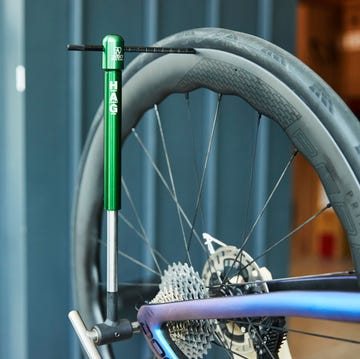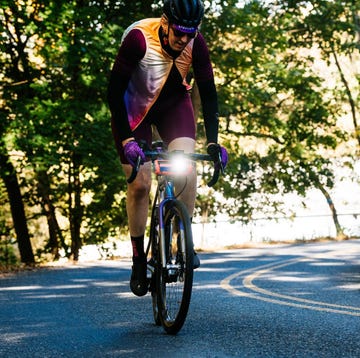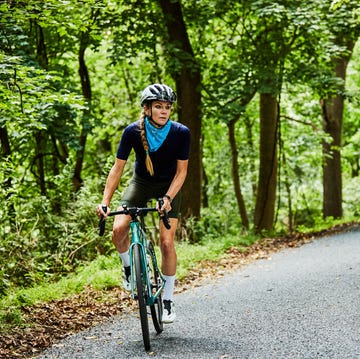If you’re anything like me, training both on and off the bike is one of your favorite things. I love thinking about training, talking about it, training others, and training myself. But here’s the thing: I don’t race. Never have with any seriousness, or with any delusions of being competitive. And, truth be told, I likely never will—it’s just not why I ride bikes.
But I still love to train in a structured way, setting goals, getting better, improving. So the question I’ve been pondering lately is: can training when you have “nothing” to train for can actually make you a better cyclist?
Answering that question can start with taking a step back and examining what riding means to us in its essence. A powerful opportunity we get when we don’t have a race or other event to train for is the time to stop and ask ourselves, “Why am I even doing this?” says Alison Powers, retired pro rider and owner and coach at ALP Cycles Coaching, “It can be easy, as an athlete, to get so focused on racing and results and to forget why we love riding bikes in the first place.”
The second potentially game-changing thing that not being beholden to a race calendar gives us is the freedom of being able to train for exactly the goals we want to focus on rather than having them dictated by our racing schedule.
“Non-racing goals can actually give a lot of control to the athlete,” says Kim Geist, owner of Kim Geist Coaching. “Oftentimes race results come down to who else is racing, the environment on the day, and other unknowns. Non-racing goals can center completely around athletes themselves, like bettering a personal skill or accomplishing something they have never attempted before. In this case, athletes can be very selective with the details of their new goals.”
Powers adds that training when you’re not racing is a great time to work on weaknesses, fix muscle imbalances within the body, try a different type of bike riding like mountain biking for roadies, or getting on a gravel bike, and spend time with family without the stresses of training, travel, racing, and recovery. Here are a few training goals that have nothing to do with a finish line and everything to do with your love of riding.
1. Ride without wearables: reconnect with how riding actually feels.
We know you love your Wahoo, Garmin, or whatever your data-delivering device of choice may be. But leaving them at home allows you to better reconnect to your body and the feel of riding.
“Riding with devices that tell you how hard or easy you’re riding, when to go hard, if your training day was beneficial or not, how much recovery you need, when to drink or eat, etc. can really hurt your overall growth as an athlete,” Powers says. “Athletes need to be in tune with their bodies. Always relying on a device to tell you what to do will only hamper your overall growth as a cyclist. Learn to listen to and work with your body.”
Geist uses riding without a device regularly as a coaching exercise. “I actually suggest riders do this at least occasionally: recording the data, but not necessarily looking at it while riding,” she says. “It’s incredibly valuable to learn how it feels to produce certain numbers and to realize that your body’s response may actually vary to produce the same numbers in different circumstances. For instance, it may feel all that much harder to produce the same power if it’s hot and humid and you’re dehydrated. Recognizing this can prompt a rider to make changes or alleviate frustration from not being able to perform as expected.”
2. Ride without GPS: navigate with analog tools, or even without a map at all.
Remember when we used to be able to find our way around without a computer on our handlebar telling us where to go? Remember how fun it felt to not know exactly where you were going? Remember how many cool roads you found this way by accident?
“This is an outstanding way to learn new routes around you to keep things mentally fresh,” Geist says. “You may also identify great stretches to accomplish structured intervals on in the future. You’ll tend to remember things better if you piece them together yourself versus being glued to a computer screen.”
It can also be a fantastic way to (re)acquaint yourself with the joys of getting a little lost. “Sometimes the ‘adventure rides’ are the most memorable,” adds Powers.
3. Master your weakest link: focus on improving specific cycling skills.
Does your sprint need work? Are climbs where you normally get dropped? Have you developed muscle imbalance that are holding your back or causing pain?
Take the time to do a deep dive into building these riding skills. We’re always working to improve as riders and get faster on the bike, but laser focusing on one specific area of your riding that has room for improvement can really pay off in terms of performance and enjoyment.
“Now’s the time to work on weaknesses, fix muscle imbalances within the body, try a different type of bike riding like mountain biking for roadies, or getting on a gravel bike, and spend time with family without the stresses of training, travel, racing, and recovery,” says Powers.
“Work on personal skills and abilities,” Geist adds. “There’s no pressure to improve on a grand scale in order to improve an impending result, so riders can put a lot of time into really refining technique and their approach to training to find what works best for them.”
4. Ride with a beginner: see cycling through fresh eyes.
The beginner’s mind might be one of the most powerful training tools there is: It can help you see cycling through fresh eyes. Riding with someone newer to the sport can be an amazing way to reconnect to what made you fall in love with cycling in the first place.
As a group, we bike racers often aren’t known for being the most humble bunch. Riding with a newbie can also be a humbling way to learn about some areas in which your own riding could improve. “This is a nice mental refresher,” Geist says. “It may allow you to notice basics in your own riding that could use some refinement. Ask yourself: Have you really mastered the tips you are giving to this newer rider?”

Natascha Grief is Bicycling’s Health & Fitness Editor. She started in the cycling industry as a bike mechanic a couple of decades ago, earning a couple pro-mechanic certifications and her USA Cycling Race Mechanic license. She went on to apprentice for framebuilder Brent Steelman in her hometown of Redwood City, California before spending several years working for both large and not-so-large cycling brands. She then switched gears and industries to earn multiple personal training certifications while honing her skills as a trainer and coach, specializing in functional training, corrective exercise, and body positive personal training. She began contributing regularly to Runner’s World and Bicycling as a freelance writer in 2020, and joined the editorial staff of Bicycling in 2022.













